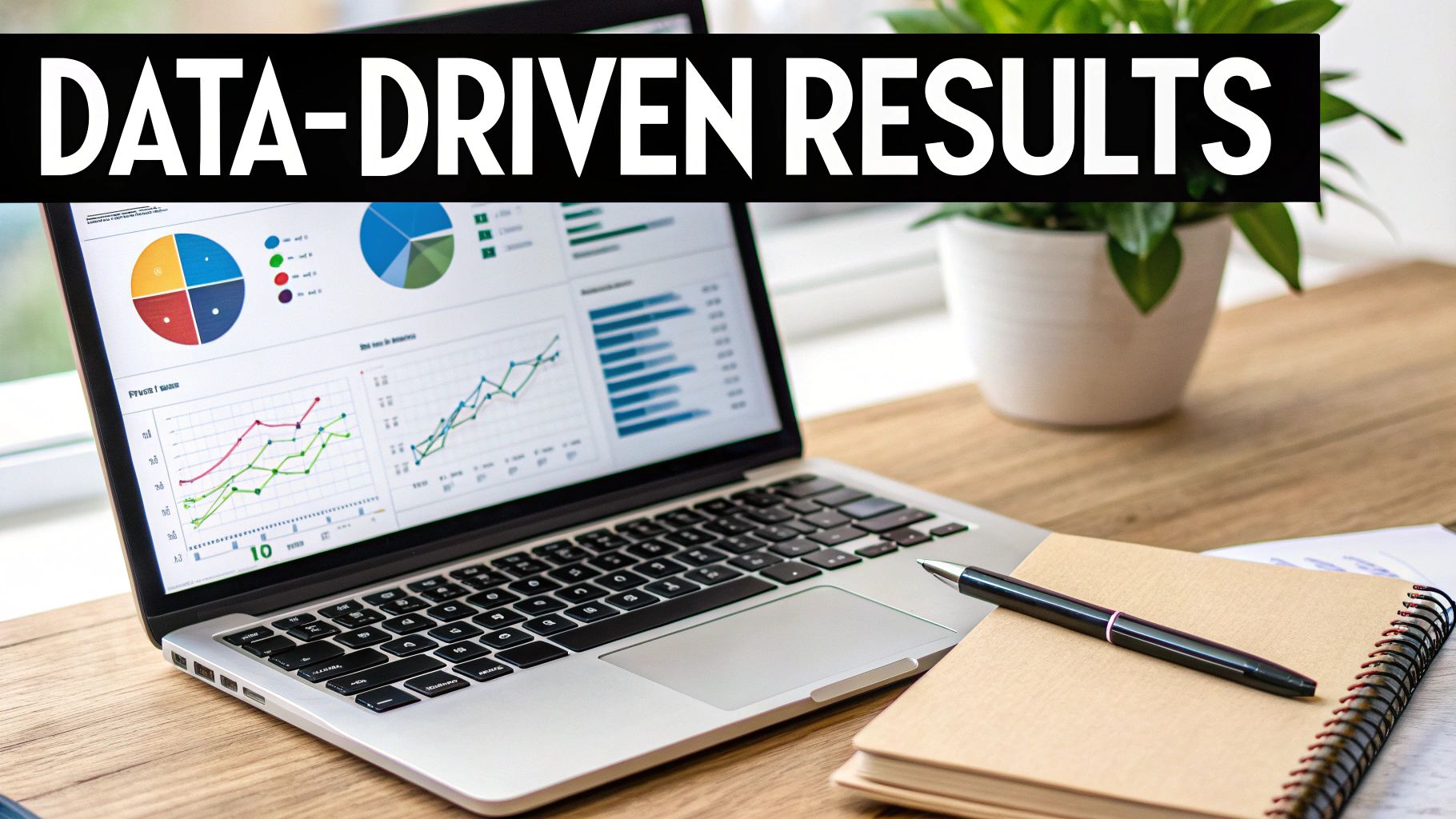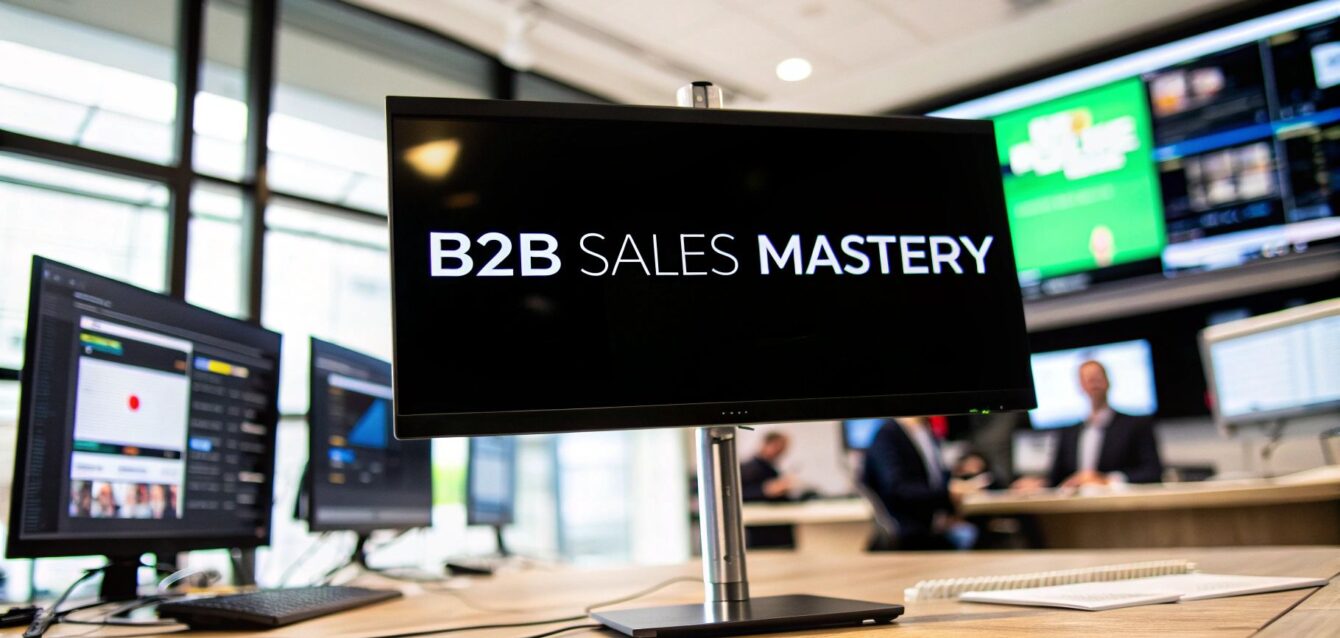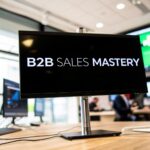Modern B2B Sales: Adapting to Digital Growth

B2B sales practices are changing fast as more business moves online. Companies still using only traditional sales methods are falling behind, since today's B2B buyers extensively research options online before ever talking to sales reps. This means businesses must rethink their entire approach to connecting with and selling to other companies.
The New Reality of B2B Sales
While person-to-person relationships remain vital in B2B sales, the rise of digital channels has changed how these connections form and develop. For instance, cold calling now plays a smaller role in finding new leads. Instead, companies need to build a strong online presence with helpful content and resources that attract potential customers. This requires closely mapping the buyer's research and decision process to provide relevant information at each stage.
Essential Digital Tools for Modern B2B Sales
Just as a craftsperson needs the right tools, B2B sales teams need appropriate digital solutions to work effectively. HubSpot and other CRM systems, marketing platforms, and analytics tools help streamline workflow and boost productivity. These systems can handle routine tasks automatically, create custom outreach, and uncover valuable patterns in customer behavior – leading to more sales and better client relationships.
Creating a Connected Sales Experience
Today's B2B buyers interact with companies through multiple channels. A prospect might first see your company mentioned on LinkedIn, browse your website, get a helpful guide, and then request a product demo. Each interaction shapes their impression of your business. That's why it's crucial to deliver consistent, personalized experiences across every platform where customers engage with you.
The Human Side of Digital B2B Sales
While digital tools matter, successful B2B sales still comes down to providing real value and building trust. Since B2B purchases often involve major investments and complex decisions, showing expertise and creating genuine connections is essential. Businesses can stand out by sharing useful content, offering custom solutions, and maintaining authentic relationships. The key is using digital capabilities to enhance rather than replace human interaction. Professional sales consulting firms help B2B companies blend personal touch with technology, using data insights and automation to support sustainable growth and meet evolving customer expectations.
Building Your High-Performance Sales Engine
Connecting effectively with potential clients and nurturing relationships is vital for B2B sales success. Yet many sales teams struggle with consistently meeting goals, let alone exceeding them. What truly sets apart successful B2B sales teams? It comes down to building a robust sales engine powered by quality training, smart compensation structures, and solid enablement processes.
Fueling Growth Through Effective Training and Development
Think of your sales team like a high-performance vehicle – even with a powerful engine, an untrained driver won't maximize its potential. The same applies to sales teams lacking proper training. Quality training programs move beyond basic product knowledge to develop critical skills like understanding customer needs, communicating effectively, and negotiating deals. Role-playing exercises help sales reps practice handling objections and presenting solutions with confidence. Regular training also keeps teams current on market shifts and sales best practices, helping them stay ahead of competitors.

Designing a Motivating Compensation Structure
A well-crafted compensation plan acts as high-octane fuel for your sales team. While base salaries provide stability, performance incentives like commissions and bonuses drive results. Research shows companies using strong customer analytics can increase earnings by 15-25%, making data-driven compensation planning essential. Consider rewarding not just closed deals but also key pipeline-building activities like lead qualification and relationship development. The compensation structure needs regular review and adjustment to stay aligned with company goals and market conditions.
Empowering Your Team With Sales Enablement
Think of sales enablement as providing your team with the right tools and resources – like giving a driver proper navigation, performance metrics, and support systems. This means access to CRM platforms, proven sales playbooks, and compelling marketing materials that streamline the sales process. For example, equipping reps with relevant case studies and testimonials helps build credibility with prospects. Effective enablement also creates a data-driven culture of improvement. By tracking key metrics, teams can spot opportunities to refine their approach for better results. Lean Sales Systems specializes in helping B2B companies scale through ROI-focused client acquisition.
Cultivating a Culture of Continuous Improvement
Building a high-performance sales engine requires ongoing focus on improvement through regular feedback, coaching and analysis. Like a pit crew reviewing race performance data, sales managers should provide constructive guidance to help team members strengthen their skills and strategies. This commitment to development, combined with proper training, compensation and enablement tools, keeps your B2B sales engine running at peak efficiency. A well-supported and continuously improving sales team can achieve exceptional results, just like a finely-tuned race car outperforming competitors.
Transforming Data Into Sales Success

A strong sales team needs more than just great training and compensation. Smart use of data analytics has become essential for growing B2B revenue consistently. Companies that effectively collect and analyze data can make better decisions to improve their sales results.
Leveraging Data to Understand Buyer Behavior
When you track how potential customers interact with your website and content, you gain valuable insights into their interests and challenges. For example, monitoring which blog posts get the most engagement reveals what topics matter most to your target audience. Sales teams can then focus their conversations on those specific pain points, making their outreach more relevant and effective. Looking at past purchase patterns also helps identify promising opportunities and predict future buying behavior, giving sales reps a real advantage in their customer interactions.
Optimizing the Sales Process with Data
The benefits of data go beyond just understanding customers – it helps improve how your entire sales process works. By analyzing metrics like how long deals take to close and conversion rates at different stages, you can spot exactly where deals get stuck and make targeted improvements. For instance, if data shows that following up within 24 hours leads to 30% more conversions, your team can prioritize quick responses. This kind of insight lets you focus on what actually works rather than guessing.
Data-Driven Pipeline Management and Territory Planning
Smart use of data helps sales teams work more efficiently across the board. Sales reps can prioritize leads that are most likely to buy based on data-backed scoring. When planning territories, looking at market data, competitor locations, and past performance helps distribute accounts strategically. Tools like Lean Sales Systems help businesses set up automated systems that use data to optimize both pipeline management and territory planning for better results.
Overcoming Data Analytics Challenges in B2B Sales
While data can dramatically improve sales performance, companies need to handle some common challenges. Bad data quality is a major issue – inaccurate or missing information leads to poor decisions. This makes it critical to clean data regularly and establish clear data governance rules. Getting sales reps comfortable using data is another hurdle. Some resist changing their approach or struggle to apply data insights effectively. The key is providing proper training and gradually building data analysis into daily workflows. By tackling these challenges systematically, B2B companies can take full advantage of data to drive more sales.
Mastering the Multi-Channel Sales Approach

While data analysis gives B2B sales teams valuable insights, success comes from skillfully combining different sales methods. The most effective approach uses both digital and traditional channels to engage potential clients throughout their buying journey. Simply existing on multiple platforms isn't enough – you need to create smooth, personalized experiences that reflect how B2B buyers actually interact with businesses, whether through social media, webinars, emails, or direct calls.
Identifying the Right Channel Mix
Every business needs its own unique combination of sales channels based on their specific market and industry. Consider how a software company targeting startups might focus heavily on social media and content marketing, while an industrial equipment supplier could get better results from trade shows and direct mail campaigns. The key is understanding where your ideal customers spend their time and what content resonates with them. This allows you to choose channels that will reach and engage your prospects most effectively.
Creating Consistent Messaging Across Channels
After selecting your core channels, maintaining consistent messaging becomes crucial. When information on your website doesn't match what your sales team is saying, it erodes trust and complicates buying decisions. Your communication needs to stay aligned across all platforms to build a strong brand identity and clear value proposition. This consistency should carry through both the specific details about your offerings and the overall tone of your messaging.
Measuring True Channel Effectiveness
Simple metrics like website visits or email opens only tell part of the story. To really understand which channels work best, you need to examine how each one feeds into your sales pipeline. For example, track how many LinkedIn leads become real opportunities and compare deal sizes between referrals and cold outreach. This detailed data shows which channels bring in the most valuable business, helping you focus resources where they matter most.
Integrating Digital and Traditional Approaches
The strongest strategies blend digital and traditional sales methods to enhance the overall buyer experience. Rather than keeping these approaches separate, use them to support each other. A targeted email campaign gains power when followed by a personal call from a sales rep who can build real rapport. Similarly, providing sales teams with helpful online content like webinars and case studies leads to more productive conversations with prospects. This combined approach takes advantage of both digital efficiency and human connection. Working with specialists like Lean Sales Systems can help B2B companies develop these integrated, results-focused systems. By thoughtfully combining multiple channels, keeping messaging consistent, and using data to guide decisions, businesses can build an effective B2B sales strategy that drives sustainable growth.
Unlocking Growth Through Subscription Models
Moving to subscription-based sales requires more than just changing your pricing structure. Success comes from carefully rethinking how you deliver value and build lasting client relationships through every stage of their journey with your company.
Evaluating the Subscription Model Fit
The first step is determining if subscriptions make sense for your specific business and customers. Does your offering naturally provide ongoing value over time? Software platforms, advisory services, and regular maintenance work tend to fit well with subscriptions. However, one-time projects or highly customized solutions may not translate as smoothly. You'll also need to assess your target market – are your customers comfortable with and willing to commit to recurring payments? Finding the right match between your offerings and customer preferences is key to making subscriptions work.
Implementing and Optimizing Your Subscription Strategy
Getting subscriptions right involves several core elements. Start by creating clear pricing tiers where each level offers tangible additional benefits – like advanced features, priority support, or specialized training. Frame your packages around concrete outcomes customers can achieve rather than just listing features. For example, emphasize how they can boost efficiency, reduce expenses, or generate more revenue. Most importantly, prioritize customer success through dedicated support teams that proactively help customers get maximum value from their subscription. This increases retention and builds loyalty for the long term.
Navigating Common Pitfalls and Maintaining Sales Team Motivation
The switch to subscriptions often faces internal hurdles, particularly from sales teams used to large one-time commissions. Design compensation plans that reward both new customer acquisition and ongoing retention through a mix of base pay, recurring commissions, and bonuses tied to customer lifetime value. Make sure your sales team fully understands and can effectively communicate the benefits of subscriptions to prospects. Train them to focus on building lasting relationships rather than just closing quick deals. Stay flexible and continuously refine your approach based on real customer feedback and market conditions. Working with experts like Lean Sales Systems can provide valuable guidance on optimizing subscription programs for sustainable growth.
By taking a thoughtful approach that emphasizes long-term customer relationships and proactively addresses key challenges, B2B companies can use subscription models to create more stable revenue streams while delivering greater ongoing value to their customers.
Future-Proofing Your Sales Strategy
Sales leaders need fresh approaches to keep up with today's rapidly shifting B2B landscape. Your sales strategy must continuously evolve while maintaining consistent performance metrics. The key is finding the right balance between trying new methods and sticking to proven fundamentals that drive results.
Adapting to Emerging Trends in B2B Sales
Digital channels have fundamentally changed how B2B sales work. Research shows that online sources will drive 56% of B2B revenue in the US by 2025, up significantly from 34% in 2021. This means integrating digital capabilities is no longer optional – it's essential for staying competitive. The good news is that digital tools can enhance rather than replace traditional relationship-based selling. For instance, data analytics helps identify the best prospects while giving reps more time to build connections.
Building an Agile Sales Team
Your team's ability to adapt determines your long-term success. Focus on ongoing training that equips reps with practical skills for today's market – from using new technologies to mastering modern sales techniques. Create a culture where people feel empowered to try different approaches and learn from both wins and setbacks. Regular coaching and skill-building sessions help your team stay sharp and ready to tackle new challenges.
Embracing Technology Without Disruption
New tech tools should make your team more effective, not create extra headaches. Choose solutions that solve real problems and fit smoothly into existing workflows. For example, a good CRM system helps manage deals while surfacing useful data insights. Automation can handle repetitive tasks so reps can focus on building relationships. Roll out new tools gradually with proper training to minimize disruption.
Creating a Flexible and Resilient Strategy
Build your strategy on solid data while staying nimble enough to shift course when needed. Track key metrics consistently, study buyer behavior patterns, and be ready to adjust tactics based on results. Have backup plans ready for potential challenges like economic changes or shifts in how customers buy. This combination of data-driven planning and operational flexibility helps maintain momentum even during uncertain times.
Assessing Your Current Sales Readiness
Take an honest look at where your sales operation stands today. Evaluate your core processes, technology stack, team capabilities, and strategic priorities. Look for gaps between your current state and where you need to be. Consider factors like:
- How efficiently do you generate and qualify leads?
- Are your sales tools and data properly integrated?
- Does your team have the right skills for modern selling?
- How well do your strategies align with buyer preferences?
Use these insights to create a focused plan for building a more resilient sales organization.
Looking to accelerate your B2B sales growth with a future-ready strategy? Lean Sales Systems specializes in building ROI-focused client acquisition systems. From sales clarity and list building to AI-powered outreach and engagement automation, we provide complete solutions for sustainable growth. Learn more at https://leansales.tech/




